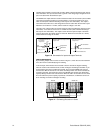
Pelco Manual C681M-D (2/02) 13
<Interface circuit inside the unit>
5V
5V
10kΩ
22kΩ
Input
terminal
0.047µF
GND
POWER ON/POWER OFF/
ALARM IN/REC/CLOCK ADJ
Input terminal
• Input Circuit
<Interface circuit inside the unit>
Output terminal
GND terminal
ALARM OUT/MODE OUT Output terminal
• Output Circuit
Using POWER ON terminal
POWER ON
terminal
ground
0V
power off
Unit's
power
DC 5V OUT
(4.5-5.5V
Max.30mA)
DC 5V
power on
power on
shut down
boot
up
Using POWER OFF terminal
POWER OFF
terminal
0V
power off
ground
shut down
power on
Unit's
power
DC 5V OUT
(4.5-5.5V
Max.30mA)
DC 5V
<Interface circuit inside the unit>
5V
5V
10kΩ
22kΩ
Input
terminal
0.047µF
GND
POWER ON/POWER OFF/
ALARM IN/REC/CLOCK ADJ
Input terminal
• Input Circuit
Figure 7. Schematics for Alarm Input and Output Terminals
3. Optional. Connect the recorder to a remote source for turning the unit on/off.
By using the POWER ON/POWER OFF terminals, it is possible to turn on/off the
recorder externally. The POWER ON terminal turns power on or off (refer to Figure 8).
The POWER OFF terminal turns power off (refer to Figure 8). Turning the recorder on/off
also controls the output of the DC 5V OUT terminal (refer to Figure 8). Figure 9 shows
the schematic for the POWER ON/POWER OFF terminals.
Figure 8. Operation of Power On and Power Off Terminals
Figure 9. Schematic for Power On and Power Off Terminals
4. Optional. Connect equipment to the CLOCK ADJ, REC, MODE OUT, and CALL OUT
terminals. Refer to Figure 10 for schematics of the input/output terminals.
The CLOCK ADJ input terminal is used for adjusting the clock. The input is active
when a ground or low voltage signal is applied. The input is non-active when the termi-
nal is open.


















